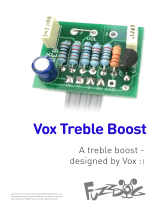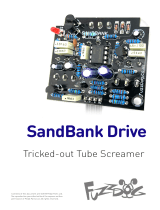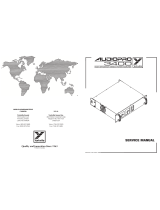Page is loading ...

Disorder DriveV2
An overdrive worth
obsessing over
Contents of this document are ©2015 Pedal Parts Ltd.
No reproduction permitted without the express written
permission of Pedal Parts Ltd. All rights reserved.

Schematic
+ BOM
Version 4
R1 1M
R2 10K
R3 470K
R4 10K
R5 2K2
R6 18K
R7 10K
R8 10K
R9 10K
R10 150K
R11 39K
R12 33K
R13 22K
R14 10R
RLED 2K2 (CLR)
C1 22n
C2 100n
C3 220p
C4 100n
C5 1n
C6 100n
C7 220p
C8 47n
C9 10u elec
C10 10u elec
C11 1u tantalum
C12 See page 4
C13 100u elec
C14 10u elec
C15 10u elec
C16 10u elec
D1 1N4001
D2 1N34A*
D4,5 1N4148
Q1,2 2N7000
IC1 TL082
IC2 7660S
GAIN 1MA
TONE 10KB
VOL 500KA
SW1-3 SPDT (ONON)
Version 1
C8 100n
GAIN 500KA
TONE 25KA
VOL 100KB
Version 2
C8 100n
GAIN 500KA
TONE 25KA
VOL 500KB
Version 3
C8 47n
GAIN 1MA
TONE 10KB
VOL 500KB
*D2 appears in very few units so is
not supplied. Add one if you want,
otherwise place a jumper across it.
Parts in green are the optional 18V charge pump. Just leave them empty if you’re not adding one.

NOTE - ignore the D-S markings on Q1-2.
We used footprint for a BS170 when
laying out the board and forgot to remove
those. You should place your 2N7000 as
per the part outline, and as shown on the
cover image. All is well.
The power and signal pads on the PCB
conform to the FuzzDog Direct Connection
format, so can be paired with the
appropriate daughterboard for quick and
easy offboard wiring.
Be very careful when soldering the diodes,
LED and transistors. They’re very sensitive
to heat. You should use some kind of heat
sink (crocodile clip or reverse action
tweezers) on each leg as you solder them.
Keep exposure to heat to a minimum
(under 2 seconds).
The striped leg (cathode) of the diodes go into the square pads.
The long leg (anode) of the electrolytic capacitors go into the square pads.
Snap the small metal tag off the pots so they can be mounted flush in the box.
Pot mounts on the back side of the board. You can use vertical-mount pots or just wire up ‘normal’ ones. It’s
a good idea to place the pots in their holes in the enclosure when you’re soldering them in place on the PCB.
That way you know they’re going to line up ok. Best way to do it is to solder a single pin of each pot in place,
then do a visual check to see that they’re all sitting at the same height. If not, melt the joints and readjust
any that are off.
If your pots don’t have protective plastic covers you should place a strip of thick card between them and the
board when soldering to keep them a good distance from the pcb to avoid shorting other components.
You should solder all other board-mounted components before you solder the pots. Once they’re in place
you’ll have no access to much of the underside of
the board.
Charge Pump
If you’re sticking with 9V just leave out the charge
pump parts (the green ones on the BOM), and add
a jumper across the switch pads shown in RED
above. If you’re adding a charge pump and want
the circuit to run at 18V all the time, add the
YELLOW jumper instead. If you want to switch
between 9V-18V, add a SPDT toggle switch in the
VOLTS pads.
PCB Layout ©2015 Pedal Parts Ltd.

There’s a spot for an extra cap - C12. Use this in conjunction with the BASS switch (SPDT)
to add or take away some bass response from the circuit. There are no rules here -
experiment with different values to find your ideal.
To increase the bass response you should add a cap with a bigger value than C2. To be
honest it’ll start getting a bit woolly. A far more useful mod is to decrease the bass. Drop
the value below that of C2. Try 68n or even as low as 47n. You’ll notice a big difference.
If you’re sticking with the stock circuit just place a jumper on the BASS switch pads as
shown on the previous page in blue.
HP/LP Switch
This is part of the original circuit and makes it very versatile.
High Peak = more distortion, more bottom end, more upper mids.
Low Peak = none of the above, less tonal colouration.
More / Less Bass Mods

Test the board!
UNDER NO CIRCUMSTANCES will troubleshooting help
be offered if you have skipped this stage. No exceptions.
Once you’ve finished the circuit it makes sense to test is before starting on
the switch and LED wiring. It’ll cut down troubleshooting time in the long
run. If the circuit works at this stage, but it doesn’t once you wire up the
switch - guess what? You’ve probably made a mistake with the switch.
Solder some nice, long lengths of wire to the board connections for 9V, GND,
IN and OUT. Connect IN and OUT to the jacks as shown. Connect all the
GNDs together (twist them up and add a small amount of solder to tack it).
Connect the battery + lead to the 9V wire, same method. Plug in. Go!
If it works, crack on and do your switch wiring. If not... aw man.
At least you know the problem is with the circuit. Find out why, get it
working, THEN worry about the switch etc.
BATTERY
IN OUT
Your nice, new circuit board
INCLUDING WIRED POTS!!!!
IN 9V GND OUT

(if using a daughterboard please refer to the relevant document)
Wire it up - DC only version
L
E
D
BOARD
OUT
BOARD
9V
BOARD
GND
BOARD
GND
BOARD
GND
BOARD
INPUT
+
IN
OUT
L
E
D
BOARD
GND
BOARD
LED+
This circuit is standard, Negative GND. Your power supply should be
Tip Negative / Sleeve Positive. That’s the same as your standard pedals (Boss etc),
and you can safely daisy-chain your supply to this pedal.
The BOARD GND connections don’t all have to connect to one point. They can be
daisy-chained around the circuit, using larger connection points (such as jack socket
lugs) for multiple connections. As long as they all connect together in some way.

(if using a daughterboard please refer to the relevant document)
Wire it up - with battery
This circuit is standard, Negative GND. Your power supply should be
Tip Negative / Sleeve Positive. That’s the same as your standard pedals (Boss etc),
and you can safely daisy-chain your supply to this pedal.
The BOARD GND connections don’t all have to connect to one point. They can be
daisy-chained around the circuit, using larger connection points (such as jack socket
lugs) for multiple connections. As long as they all connect together in some way.
L
E
D
BOARD
OUT
BOARD
9V
BOARD
GND
BOARD
GND
BOARD
GND
BOARD
INPUT
BATTERY
+
IN
OUT
L
E
D
BOARD
GND
BOARD
LED+
+

Drilling template
Standard Switch
Hammond 1590B
60 x 111 x 31mm
Recommended drill sizes:
Pots 7mm
Jacks 10mm
Footswitch 12mm
DC Socket 12mm
Standard Toggle Switch 6mm
This template is a rough guide only. You should ensure correct marking of your
enclosure before drilling. You use this template at your own risk.
Pedal Parts Ltd can accept no responsibility for incorrect drilling of enclosures.
PedalParts.co.uk
32mm
21mm
5mm
It’s a good idea to drill
the holes for the board-
mounted parts 1mm
bigger to give yourself
some wiggle room,
unless you’re a drill ninja
5mm
/













